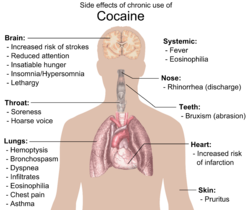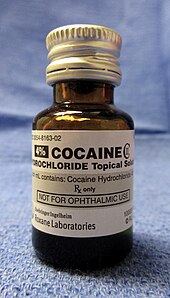Cocaine is a powerful nervous system stimulant.[10] Its effects can last from 15–30 minutes to an hour, depending on dosage and the route of administration.[11]
Cocaine increases alertness, feelings of well-being and euphoria, energy and motor activity, feelings of competence and sexuality. Athletic performance may be enhanced in sports where sustained attention and endurance is required. Anxiety, paranoia and restlessness are also frequent. With excessive dosage, tremors, convulsions and increased body temperature are observed.[10]
Occasional cocaine use does not typically lead to severe or even minor physical or social problems.[12][13]
Acute
Main article: Cocaine intoxication
With excessive or prolonged use, the drug can cause itching, tachycardia, hallucinations, and paranoid delusions.[14] Overdoses cause hyperthermia and a marked elevation of blood pressure, which can be life-threatening.[14]
Chronic
Chronic cocaine intake causes brain cells to adapt functionally to strong imbalances of transmitter levels in order to compensate extremes. Thus, receptors disappear from the cell surface or reappear on it, resulting more or less in an "off" or "working mode" respectively, or they change their susceptibility for binding partners (ligands) – mechanisms called down-/upregulation. However, studies suggest cocaine abusers do not show normal age-related loss of striatal dopamine transporter (DAT) sites, suggesting cocaine has neuroprotective properties for dopamine neurons.[15] The experience of insatiable hunger, aches, insomnia/oversleeping, lethargy, and persistent runny nose are often described as very unpleasant. Depression with suicidal ideation may develop in very heavy users. Finally, a loss of vesicular monoamine transporters, neurofilament proteins, and other morphological changes appear to indicate a long term damage of dopamine neurons. All these effects contribute a rise in tolerance thus requiring a larger dosage to achieve the same effect.[16]
The lack of normal amounts of serotonin and dopamine in the brain is the cause of the dysphoria and depression felt after the initial high. Physical withdrawal is not dangerous, and is in fact restorative. Physiological changes caused by cocaine withdrawal include vivid and unpleasant dreams, insomnia or hypersomnia, increased appetite and psychomotor retardation or agitation.[17]
Physical side effects from chronic smoking of cocaine include hemoptysis, bronchospasm, pruritus, fever, diffuse alveolar infiltrates without effusions, pulmonary and systemic eosinophilia, chest pain, lung trauma, sore throat, asthma, hoarse voice, dyspnea(shortness of breath), and an aching, flu-like syndrome. Cocaine constricts blood vessels, dilates pupils, and increases body temperature, heart rate, and blood pressure. It can also cause headaches and gastrointestinal complications such as abdominal pain and nausea. A common but untrue belief is that the smoking of cocaine chemically breaks down tooth enamel and causestooth decay. However, cocaine does often cause involuntary tooth grinding, known as bruxism, which can deteriorate tooth enamel and lead togingivitis.[18] Additionally, stimulants like cocaine, methamphetamine, and even caffeine cause dehydration and dry mouth. Since saliva is an important mechanism in maintaining one's oral pH level, chronic stimulant abusers who do not hydrate sufficiently may experience demineralization of their teeth due to the pH of the tooth surface dropping too low (below 5.5).
Chronic intranasal usage can degrade the cartilage separating the nostrils (the septum nasi), leading eventually to its complete disappearance. Due to the absorption of the cocaine from cocaine hydrochloride, the remaining hydrochloride forms a dilute hydrochloric acid.[19]
Cocaine may also greatly increase this risk of developing rare autoimmune or connective tissue diseases such as lupus, Goodpasture's disease,vasculitis, glomerulonephritis, Stevens–Johnson syndrome and other diseases.[20][21][22][23] It can also cause a wide array of kidney diseases and renal failure.[24][25]
Cocaine misuse doubles both the risks of hemorrhagic and ischemic strokes,[26] as well as increases the risk of other infarctions, such asmyocardial infarction.[27]
Addiction
Main article: Cocaine dependence
Cocaine dependence (or addiction) is psychological dependency on the regular use of cocaine. Cocaine dependency may result in physiological damage, lethargy, psychosis, depression, akathisia, and fatal overdose.
Biosynthesis
Main article: Biosynthesis of cocaine
The first synthesis and elucidation of the cocaine molecule was by Richard Willstätter in 1898.[28] Willstätter's synthesis derived cocaine from tropinone. Since then, Robert Robinson and Edward Leete have made significant contributions to the mechanism of the synthesis. (-NO3)
The additional carbon atoms required for the synthesis of cocaine are derived from acetyl-CoA, by addition of two acetyl-CoA units to the N-methyl-Δ1-pyrrolinium cation.[29] The first addition is a Mannich-like reaction with the enolate anion from acetyl-CoA acting as a nucleophile towards the pyrrolinium cation. The second addition occurs through a Claisen condensation. This produces a racemic mixture of the 2-substituted pyrrolidine, with the retention of the thioester from the Claisen condensation. In formation of tropinone fromracemic ethyl [2,3-13C2]4(Nmethyl-2-pyrrolidinyl)-3-oxobutanoate there is no preference for either stereoisomer.[30] In the biosynthesis of cocaine, however, only the (S)-enantiomer can cyclize to form the tropane ring system of cocaine. The stereoselectivity of this reaction was further investigated through study of prochiral methylene hydrogen discrimination.[31] This is due to the extra chiral center at C-2.[32] This process occurs through an oxidation, which regenerates the pyrrolinium cation and formation of an enolate anion, and an intramolecular Mannich reaction. The tropane ring system undergoes hydrolysis, SAM-dependent methylation, and reduction via NADPH for the formation of methylecgonine. The benzoyl moiety required for the formation of the cocaine diester is synthesized from phenylalanine via cinnamic acid.[33] Benzoyl-CoA then combines the two units to form cocaine.

